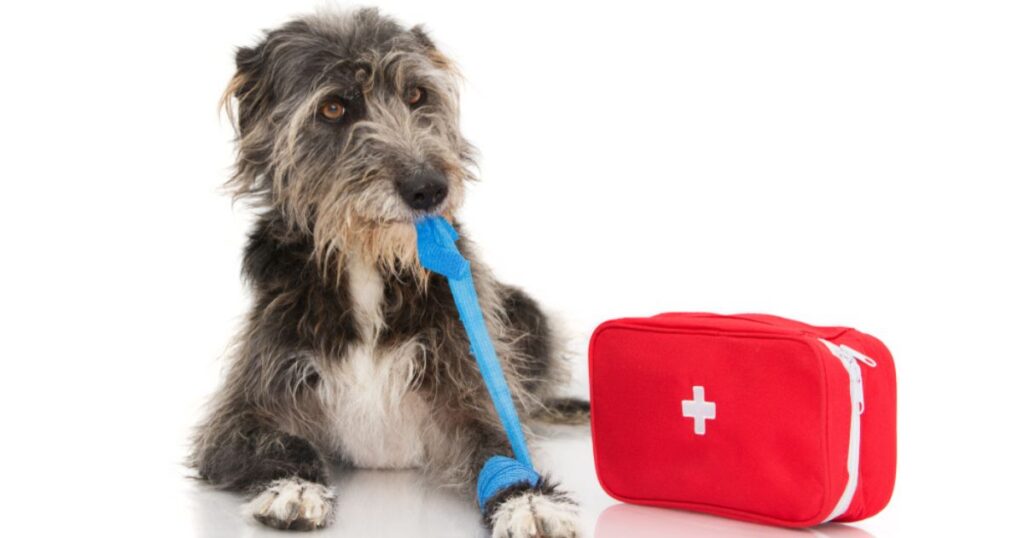- Pumpkin Team
- May 28
- 5 min read
Updated: Nov 3
Key Points
Neosporin may help with small cuts on dogs but comes with risks.
Licking off Neosporin can lead to poisoning or delayed wound healing.
Always consult your veterinarian before using any human medication on your pet.
Dog-safe alternatives like pet-specific antibiotic ointments are a better choice.
Caring for your furry friend is a top priority, especially when accidents happen. If your dog has a minor cut or scrape, you might wonder if you can use Neosporin on dogs. While Neosporin is a staple in many human first-aid kits, its use on dogs can be a little more complicated than you think.
Can you use Neosporin on a dog wound?
Neosporin (bacitracin / neomycin / polymyxin B) is an over-the-counter antibiotic ointment that prevents infections in minor human wounds. The three antibiotics in Neosporin are designed to reduce the risk of infection and support healing. While it might seem harmless, using Neosporin on your dog comes with risks:
Licking risks

When dogs lick Neosporin off their skin or wounds, they can ingest harmful ingredients like polymyxin B, neomycin, and bacitracin. This can lead to an upset stomach, vomiting, diarrhea, or a more serious allergic reaction.
Continuous licking may also prevent the wound from healing properly. The ingestion of Neosporin could disrupt a dog’s gut microbiome, causing further digestive issues.
Allergic or adverse reactions
Dogs can experience allergic or adverse reactions to Neosporin, including redness, swelling, itching, or hives at the application site. These reactions may indicate sensitivity to ingredients like neomycin or polymyxin B.
Severe cases might involve systemic responses such as difficulty breathing, vomiting, or lethargy. Regular use could also result in skin irritation or secondary infections. If any unusual symptoms arise after applying Neosporin, discontinue use immediately and seek advice from a veterinarian to ensure your pet's safety and well-being.
Delayed veterinary care
Relying on Neosporin at home can sometimes delay essential veterinary care that your dog may require. While minor cuts or scrapes might seem manageable with topical treatments, underlying issues such as infections, deeper puncture wounds, or allergic reactions could go unnoticed and worsen over time.
Using Neosporin might temporarily mask symptoms, leading to a false sense of security. Getting a prompt assessment by your veterinarian will ensure that serious conditions are addressed correctly in a way that prevents complications. Early professional intervention can be crucial for your dog's health and recovery.
When should you use Neosporin?
Neosporin can be used on minor cuts or scrapes on a dog to prevent infection and promote healing, but we recommend consulting your veterinarian first. Ensure the wound is cleaned beforehand, and apply a small amount. Avoid using it on deep wounds or near the eyes.
Pro tip: When your dog gets a cut or a wound, we know you want to do what's best for them. Before reaching for the human first aid kit, we'd recommend seeking a veterinary professional's opinion. There are also dog-specific first aid kits you can keep around if you've got a pup with trouble for a middle name.
Possible side effects of using Neosporin on dog wounds

While Neosporin is commonly used to prevent infections in minor cuts and wounds for humans, applying it to your dog's injuries can lead to some side effects.
Side effects can include:
Irritation of the wound
Delayed wound healing
Allergic reaction
Gastrointestinal distress
Antibiotic resistance
If you haven't used it before, Neosporin can cause an allergic reaction to the ointment. Some dogs may develop redness, swelling, itching, or irritation at the application site due to sensitivity to one or more of Neosporin’s ingredients. This can exacerbate discomfort and delay the healing process.
Dogs often lick themselves, which can lead to the ingestion of Neosporin. Consuming the ointment might cause gastrointestinal distress, including vomiting, diarrhea, or loss of appetite. Prolonged ingestion or large quantities could increase the severity of these symptoms.
In addition, overuse of topical antibiotics, including Neosporin, could contribute to antibiotic resistance, which could make future bacterial infections harder to treat and require stronger
medications.
Symptoms of Neosporin poisoning in dogs
If your dog accidentally ingests Neosporin, watch for symptoms such as:
Drooling or gagging
Vomiting or diarrhea
Loss of appetite
Lethargy or confusion
If your dog exhibits symptoms of Neosporin poisoning, act quickly to ensure their safety. Begin by contacting your vet or an emergency animal poison control hotline for guidance. Avoid attempting to induce vomiting unless specifically instructed by a veterinary professional, as this can sometimes worsen the situation.
Monitor your dog's behavior closely and try to identify how much Neosporin they may have ingested. Provide your vet with detailed information about your dog’s symptoms, weight, and the potential quantity consumed. Early intervention is critical, so don’t delay in seeking professional help to ensure your dog’s recovery.
How Is It Treated?
Neosporin poisoning treatment may include:
Activated charcoal to prevent further absorption of toxins
IV fluids to flush out the active ingredients
Anti-nausea medications to soothe upset stomachs
How to identify an infection in your dog's wound
An infected wound in a dog can exhibit several warning signs. Look for redness, swelling, or discharge such as pus around the wound, as these may indicate infection. The area might feel warm to the touch and have a foul odor.
Your pet’s behavior can also provide clues. They might lick or chew the wound excessively, seem more irritable, or avoid activity due to pain. Other symptoms may include lethargy, loss of appetite, or noticeable limping if the wound is on a limb. Regularly monitoring the wound and your dog’s behavior is essential for early detection and timely treatment.
Steps to take for an infected wound:
Avoid applying additional ointment or home remedies.
Use dog-safe antiseptic cleaners for initial care.
Schedule an immediate veterinary visit for antibiotics or further treatment.
It’s critical to address infections early to avoid further complications, such as abscesses or systemic illnesses.
Is Neosporin safe for dogs?
While Neosporin can technically be used on dogs in limited, vet-approved situations, it isn’t the safest or most effective DIY option. Thankfully, there are plenty of dog-safe alternatives that prioritize your pup’s health and healing.
If your dog’s injury seems severe or you’re unsure about treating it at home, schedule a visit with your veterinarian. Prompt professional care is always the best course of action when it comes to keeping your furry friend safe and well. If you don’t want to worry about minor health hiccups for your pet — and have extra peace of mind –– get a free quote from Pumpkin Pet Insurance for your fur child today.
FAQs
What should I do if my dog licks off Neosporin?
Monitor for symptoms like vomiting, diarrhea, or lethargy. Contact your vet immediately if you observe any signs of poisoning. A small amount may not cause any severe symptoms but you should keep a close eye on them and take them to their vet if you do have any worries.
Can I use Neosporin on a dog bite wound on my dog?
It is not recommended to use Neosporin on a dog bite wound. Dog bites can introduce bacteria deep into the tissue, increasing the risk of infection, which may require professional treatment. Consult your vet for appropriate wound care and to determine if antibiotics or other treatments are necessary.
Does Neosporin help with infection in dogs?
While it can prevent bacterial growth, Neosporin isn’t the ideal treatment due to the risks of licking and potential allergies. Use pet-specific antibiotic ointments instead.
Can you use Neosporin on a dog’s paws?
While Neosporin can be used on minor cuts or scrapes on a dog’s paws, it should be applied with caution. Paws often come into contact with various surfaces, making it likely that your dog could lick the ointment off, which may lead to ingestion and potential stomach upset.

